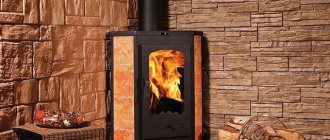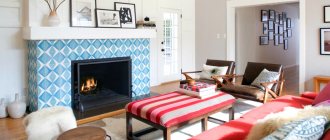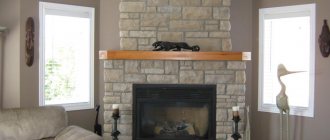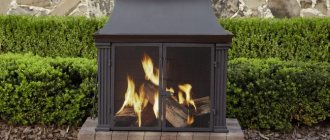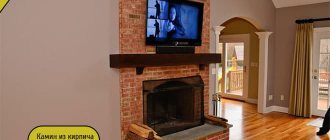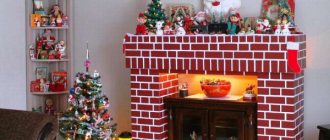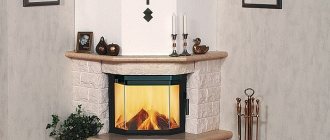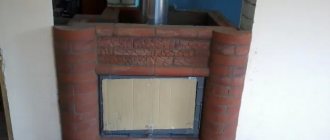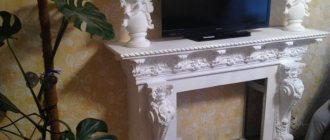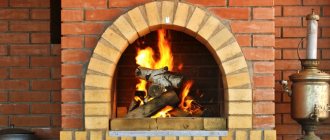To build a fireplace with your own hands, you need to model its design project in advance. The choice of shape and dimensions depends on preference. Materials are purchased taking into account the type of device and its design. The total cost of the equipment will depend on many factors, including the layout of the building.
You can build a fireplace with your own hands.
Features of a fireplace in a private house
Modern models for heating rooms are designed for any interior and area. Fireplaces are installed in living rooms, attics, balconies, terraces and even in a niche under the stairs. Some models are created solely for aesthetic purposes.
The construction of decorative fireplaces does not require approval from regulatory authorities, and their installation takes no more than 1 day. Before starting to purchase materials, the homeowner should study the characteristics of the equipment and select the right model based on their needs.
Functional purpose
Fireplaces are installed for additional heating of the room. The heat transfer of the device is low compared to the stove. The main purpose is interior decoration, creating an atmospheric area for relaxation or cooking (kitchen).
Principle of operation
A fireplace is considered an analogue of a stove. Fuel is burned in the combustion chamber, the smoke from which is removed through the pipe under the influence of draft. The operating principle of other types of devices depends on the fuel used. For example, electric and bio-fireplaces do not require ventilation hoods at all.
The principle of operation of the fireplace.
Advantages
There are many positive aspects. If you wish, you can arrange the fireplace yourself.
Advantages of the building:
- Creates an aesthetic perception of space in the room (comfortable seating area).
- It is an additional source of heat and reduces humidity.
- Used for cooking at any time of the year.
- Serves as the main element in a heating system with gas and water circuits.
A practical feature of fireplaces is their versatility. In the event of a power outage or early cold weather, the device is able to maintain a comfortable temperature in at least one room.
Equipment classification
Before you build a Swedish stove or any other structure, you need to remember that any heating equipment consists of a portal, which serves as protection for the firebox and its decoration. Most often this element is assembled from brick. Can be lined with any heat-resistant materials. To place logs and burn them, the structure is equipped with a firebox or combustion compartment. To prevent smoke from immediately escaping into the street and creating heat, the stove is supplemented with a smoke collector. To remove smoke and combustion products, wood-burning stoves are equipped with a chimney.
An open firebox design means there is no door. In this case, special attention must be paid to the internal walls of the combustion chamber, making them as thick, durable and airtight as possible. For laying the walls, only fireclay bricks and an adhesive composition based on fireclay clay are used. Also, the fireplace insert can be of a closed type.
A closed firebox is safer to use. It prevents sparks and flames from entering the room. However, an open firebox looks more harmonious and allows you to contemplate the bright flame, enjoy its crackling and warmth to the fullest. In addition, by giving preference to an open design, you save your money, which could have been spent on purchasing a steel or cast iron chamber with a door.
In order to protect the room from fire, the space next to the firebox must be insulated with any fireproof material.
If you want to equip a stone portal with a purchased firebox, the walls of the stove can be assembled from simple brick, since additional protection will be provided by cast iron sidewalls.
A closed firebox is most often equipped with a door made of transparent tempered glass, which allows you to see the fire burning in the hearth in as much detail as possible. The method of opening such a door can be either the classic side or the top. Many modern fireboxes are equipped with a self-cleaning system - this prevents soot and soot from forming on the glass.
Wall- and corner-type fireplaces are equipped with steel pipes, which do not have a very presentable appearance. In order to hide and at the same time decorate such a chimney, it is enclosed in a box made of brick. The laying of the chimney is also carried out according to a previously drawn up order. Such a box not only improves the appearance of the structure, but also enhances, further insulates and accumulates accumulated heat.
Most often, stylish steel hoods that are hung directly above the hearth itself are purchased as a set for an island fireplace.
Fireplace design
The installation has 4 main modules.
Firebox
This is a stone or steel niche in which a fire is lit. Fireboxes are of open or closed type (with glass, door).
Chimney
This is a chamber for removing combustion products through a pipe. Smoke collectors require periodic cleaning of soot.
Base
This is the fireproof foundation on which the fireplace stands. The base material is selected taking into account the dimensions of the structure.
Portal
This is a decorative frame for the fireplace, a frame designed in the shape of the letter “P”. Portals can be made from any material - wood, ceramics, stone.
Chimney construction technology
The chimney can be laid using the same mortar; the design, in principle, requires the same fire-resistant properties. The only thing is that it is preferable to “plant” the area located above the roof on cement. Even at the time of installation, it is recommended to rub and level the inner walls so that there are no turbulences and backdraft, and the channel will become clogged much less often. Also, do not forget that it is necessary to install a damper between the masonry of the fireplace and the chimney.
There are some nuances in construction in places of passage; remember that if you do not provide thermal insulation, then you must do “joining” to separate hot air from flammable materials. But, of course, it is better to make reliable insulation, use classic wool and “galvanization”. Make a special apron that will close the gaps between the brick and the roof covering
Don’t go wrong with the dimensions, it is important that the chimney meets classical standards and has reliable and proper operation
In conclusion of today’s article, I would like to say that it is very important to pay attention to every little thing, which in the end can become an irreparable source of trouble for the entire heating system
Style solutions
The appearance of the fireplace should complete the interior of the room, correctly placing accents.
Russian style
Fireplaces of this type are painted with Slavic symbols or decorated with enameled tiles. The chimney is lined with plaster or artistic plaster. The shape of the structure resembles the letter “D” in country style. The peculiarity of fireplaces is their massiveness, simplicity and abundance of decorative elements.
Classic
Fireplaces are made from natural materials - stone, cast iron, brick with marble lining or solid wood. The style is consistent with a minimum number of decorative elements. Classics are characterized by massive structures, the presence of columns, bas-reliefs and forged accessories.
Modern
The style is characterized by minimalism and practicality, so the fireplace can be placed in homes with high-tech, loft, art nouveau, etc. designs. The shape of the structure is a small rectangle. The chimney is masked with a canopy or “recessed” into the wall. The firebox is covered with a glass panel or left open.
Rustic
Fireplaces of this type are not richly decorated. The style is primitive, rustic, with rough stone processing. Heating devices will harmoniously fit into the interior with wall panels made of wood and stone.
Where to install a fireplace installation
The fireplace can be built into the wall partition of the house. Typically, such construction is planned at the construction stage.
Another option is an attached structure, which will already require its own space. Corner type fireplaces are convenient for construction in square-shaped rooms.
How to make a fireplace with your own hands
Work begins with a drawing of the intended design (photo). Based on the calculated dimensions, an estimate is drawn up, according to which the necessary materials and equipment are purchased.
When building fireplaces with gas or water heating, a contractor is hired and a warrant is sought from the local administration. Fake fireplaces are installed in 2-3 days, but installing a full-fledged structure with a live fire can take up to 2 months.
The manufacturing technology of the device completely depends on the type of construction and ventilation system.
Preparatory work
Work on arranging a corner fireplace begins with the construction of the base. It is strictly forbidden to connect the foundation of the structure under construction with the base of the main building - this will lead to very unfavorable consequences.
To determine the optimal width of the foundation, add about 50 mm to the width of the front plinth row. Determine the length in accordance with the dimensions of the side row of the plinth. In general, the dimensions of the base should be slightly larger than the dimensions of the future fireplace.
When choosing a place for arranging the foundation and the fireplace itself, make sure that in the future the smoke exhaust pipe does not pass through the elements of the roof rafter system and beams.
The foundation is made extremely simply - a pit of the required size is dug, the bottom of the pit is covered with waterproofing, a layer of a mixture of sand and crushed stone is poured on top, reinforcement is laid and mortar is poured.
Building a foundation for a fireplace
Building a foundation for a fireplace
Allow the foundation to gain strength and cover it with a double layer of roofing felt.
While the foundation hardens, begin preparing building materials for upcoming use. So, the clay must first be soaked in water for a couple of days. Soak the bricks for the same amount of time.
Fireplace foundation laying diagram
Pre-calibrate the bricks you have. Elements with significant deviations from the previously mentioned size cannot be used for masonry.
To prepare the solution, use a standard and proven recipe. Pour the dry sifted sand into the clay pulp, and then mix the resulting mixture thoroughly. Determine the required amount of water individually. The finished mixture should have the consistency of jelly.
Fireplace mortar
Check the finished solution. To do this, roll a sample out of it into a “sausage” about 1.5 cm in diameter. If the sample does not stick to your hands, holds its given shape normally and does not fall apart, everything is fine.
Also check how the solution you prepared behaves directly on the brick. To do this, place the mixture on the building element. It is necessary that the solution does not stick to the trowel, does not fall apart and does not spread over the brick under its weight.
Design options
The creation of fireplace installations can be realized using any materials. However, in this case the heating function will remain in question. The designer will have to think through everything to the smallest detail.
From plasterboard
Universal KGL panels are suitable for installing fireplaces of any shape. The basis of the structure is a metal or wooden frame. In place of the firebox, decorative grilles and LCD screens with a heating element are installed. There are a lot of options for cladding - from painting to finishing with decorative brick or stone.
A fireplace of any shape can be mounted from plasterboard.
Made of cast iron
The material is used to create wood-burning stoves on legs or fireboxes for brickwork. You cannot use a cast iron fireplace all the time. In addition, when installing a stove independently, you should insulate it with a fireproof screen and lay a stone podium.
Cast iron fireplaces.
Made of metal
Steel and its alloys withstand maximum temperatures. Externally, metal fireplaces resemble potbelly stoves with legs. They are installed even in rooms with linoleum or laminate. Installation of steel fireplaces requires the removal of the chimney, as well as the protection of the walls in contact with the surface of the stove.
Metal fireplaces can withstand high temperatures.
Made of brick
The material has high strength when heated above 1000°C. Fireplaces made of fireclay bricks are the most durable. They can be used for any type of homemade stoves. The main requirement is that the brick must be non-hollow, solid, without chips or cracks. The cladding is done with any other material.
Brick fireplaces.
Made of wood
The material is used in decorative fireplaces with LED (electronic lighting). The portal itself can be made from parquet boards, wood panels, plywood or solid wood. The shape of the fireplace will be standard.
Fireplace wood is used for decorative purposes.
From boxes
Cardboard fireplaces act as temporary decorations. Facade cladding is the most labor-intensive part of the work. With due diligence, a false fireplace can be built in 1 day if you prepare a drawing, a tabletop in advance and purchase soft panels for covering the product (brick wallpaper, foam baguette). The free opening of the fireplace is decorated with a garland and a figured picture with fire.
Fireplaces made from boxes.
From foam plastic
The material is more durable than cardboard. It is convenient because the master does not need to measure each joint. Simply take a voluminous piece of polystyrene foam and carefully cut out the central part. Next, glue the base and tabletop. The facade of the product is decorated with baguette and soft brick. In place of the firebox, you can put an LED panel (candles, garland, fireplace decoration).
A foam fireplace is stronger than a cardboard one.
Water
The installation of such a fireplace is planned during the construction of a house (extension). The water heating pipe is connected to a system of heating ducts inside the walls and foundation. Independent installation of equipment can only be carried out by an experienced specialist.
Fireplaces with water heating circuit.
Electric
Fireplaces with imitation flames are built into a wall niche or portal. Equipment is purchased to order. Budget models are presented in ready-to-install options - in the form of wall-mounted plasmas.
Electric fireplaces.
Street
A copy is placed on a personal plot or under the roof of a terrace or gazebo. An outdoor fireplace functions as a stove, barbecue, smokehouse, or barbecue. The design can be equipped with an oven, sink, countertop, shelves and bar.
Outdoor fireplaces.
Stone
Granite and marble are the main materials for fireplaces. If you have a sufficient budget, the fireplace can be built in a single block. The mass version is a brick oven lined with polished sheets, tiles, and small river stones.
Stone fireplaces do not require complex maintenance.
Gas
The fireplace generates heat through a fuel burner. The device is connected to a central gas supply or a liquefied propane cylinder. The reducer supplies gas to the burner, maintaining the flame.
Gas fireplaces.
Any portal material can be used. Installation of the structure is carried out only by licensed contractors.
Gel
The fireplace emits a minimal amount of heat and is more of a decorative installation. To ignite the fire, a glass chamber is used, at the base of which there is a built-in channel for biofuel. It is often decorated with smooth stones. Gel (alcohol) fireplaces have a combustion intensity control function. Models with remote control are also available for sale.
A gel fireplace uses a glass chamber to light the fire.
Additional items
In addition to the listed parts, other parts are also involved in the design of the fireplace:
- Grate. In other words, this is a grate that is located at the bottom of the firebox and is used to lay firewood on it. Thanks to the installed grates, uniform combustion of the fire is achieved due to the supply of air.
- Blower. It is located at the bottom of the device and serves to supply the chimney with sufficient draft. Its second purpose is air access to the grate. Fireplace elements
- Ash pit. This is a chamber located under the grate, designed to collect combustion products, which is why it is installed in wood heating devices. In some models, this element acts as a blower.
- Smoke collector. It is located in the lower part of the structure and is designed to perform the functions of an exhaust hood, which is located above the firebox. Its main purpose is to ensure the removal of combustion waste into the chimney, preventing it from penetrating inside the house.
- Damper or gate. It is located in the pipe slightly above the smoke collector. When the fireplace is not working, the damper closes the chimney, providing protection against hot air escaping outside. In addition, the gate helps regulate the traction force.
Stages of constructing a fireplace
The device for heating the recreation area is constructed in accordance with the approved drawings.
Main masonry elements:
- Ventilation tube.
- Smoke tooth.
- Chamber for gas removal.
- Back plate.
- Ash pit (ash pan).
- Grate.
- Firebox.
- Under.
- Podium.
- Portal (with or without cornice).
A separate foundation for the fireplace is poured in advance. It should be 10 cm wider than the structure. If there is a gap between the cement and the floor level in the room, the base of the fireplace is raised. Re-formwork and drying of the cement mortar will be required.
Masonry
The formation of the fireplace itself begins from the zero level - two rows of bricks, the first of which is placed edge-on, the second - flat.
Laying stages:
- The dried concrete is covered with felt, a piece of iron, and 2 sheets of roofing felt. Cover the layers with a second layer of steel.
- Lay the zero row of bricks below the floor level. Close all gaps.
- The first row is laid out from the corners to the center. The free space is filled with sand-clay mortar. Another 2-3 rows make up the base.
Laying a fireplace is a difficult process that requires careful attention from the master.Next, create a hole for the ash pan (with a door). The height of the masonry depends on the power and size of the fireplace. Additionally, 2 heater channels can be allocated (to exhaust hot air).
- The next rows frame the walls of the firebox, tapering in depth down to the 10th level. A grate is placed directly above the heil.
- Rows 11-13 create an overlap that turns into a smoke exhaust chamber. From level 13, a special type of masonry is formed, which makes it possible to eliminate reverse draft (smoke in the room). At this stage, the formation of the arched vault begins. Order schemes are downloaded from the Internet.
- At levels 13-14, air wells (suffocators) are formed. Through them, hot air enters the room. The energy efficiency of the structure increases by 20%.
- A steel heat-reflecting screen is attached to the upper part of the rear wall of the firebox. The pins are driven in with adjustment at the stage of laying the back wall. In another design option, this step is skipped, because More often they use ready-made steel fireboxes from the store.
Starting from the 15-20th row, the chamber is covered with a grate and proceed to the construction of the chimney. If desired, you can complete the laying at this stage. The steel pipe built into the firebox is simply led out onto the roof.
Building a chimney
The chimney is laid out in accordance with the dimensions.
This part of the building is laid out in compliance with strict dimensions. When installing a finished firebox, the diameters of the joint (pipe) and the chimney are selected in advance. To erect a structure yourself, you need to calculate the cross-section (square, rectangular). Otherwise the fireplace will have no draft.
The brick chimney exhaust channel has dimensions of 20x25 cm when laying out the firebox with sides of 60 and 75 cm. Starting from the 20th row, solid bricks are laid out at an angle of 30° (inside the firebox). At the same time, it is extended exactly a quarter. This is how a fireplace tooth is formed (a pass in 5 rows). The chimney takes the form of an inclined elbow, which turns into a vertical channel. Pins are inserted into the seams of the bottom row of bricks. The upper part of the steel sheet is attached to them, the placement of which was planned during the construction of the rear wall.
On 25-26 rows of bricks, a channel is laid to remove smoke masses. After 4 levels, the masonry section is expanded to its original value up to contact with the roof. For masonry above the roof (riser, otter, neck, cap) use durable brick soaked in cement-clay mortar for 5 minutes.
Rules for the construction of chimneys:
- The structure is laid along adjacent (internal) walls. Load-bearing (external) structures are not used for masonry due to heat loss.
- The length of the pipe, or more precisely, its part visible from the street, should not exceed 50 cm.
- The passage openings must provide complete smoke exit.
- The reflector and umbrella above the roof with brickwork do not need to be installed.
In ready-made fireboxes from the store, the chimney is assembled according to the instructions. The joint seam is treated with sealant. The walls around the chimney are protected with heat-resistant material. To install the pipe to the ceiling, create a box with a margin of 20-25 cm around the perimeter. The structure protects the wooden elements of the vault.
The insulating materials are mineral wool or expanded clay. The box with the head is covered with a water-repellent fabric (flexible), and a metal passage (with an umbrella) is screwed on top. Ready-made copies are purchased at construction stores.
Arch formation
The design is formed starting from 9-10 rows and ending with the 15th level. The arc bricks are cut with a grinder to the desired shape. In the front part of the masonry, only solid briquettes are used.
Types of arches:
Straightforward
It is formed from bricks ground into wedges at the base. Rarely used in construction.
Semicircular
It is formed from bricks ground into a cone at the base. The shape of the resulting structure is a steep semicircle.
Luchkovaya
It is formed from ground bricks, the radius of curvature of which is calculated using a special formula. The shape of the resulting structure is flat.
Additionally, the vault can be formed using the screed or overlap method (wedge, overlap).
In all cases, the structure is laid under a temporary support-base. The gaps are filled with mortar.
Cladding works
At the final stage of construction, finishing is carried out with decorative materials (heat-resistant). The most common option is facing brick, plaster, ceramics, stone. If new brick was used during masonry, the structure does not need to be faced.
Video
Mantel
Fireplace cladding options. Useful tips and error analysis.
With factory firebox
If there are metal stoves, then why not metal fireplaces? And they are. Fireplace inserts are made from complex alloys - organosilicon, composite and special. The processes occurring in the fireplace insert are simulated by special programs, which is why the efficiency of these heating devices is high and the complexity of installation is average. Another advantage is that you can connect a regular metal chimney.
Another nice point: the weight of the firebox is about 100 kg. If the finish weighs a little, you can place such a fireplace on a reinforced concrete slab. If you want natural stone, you will have to make a foundation for the fireplace.
When installing a fireplace with a firebox, you must comply with a number of requirements:
- the walls near which the heating device will be mounted must be covered with non-flammable materials and thermal insulation with a reflective layer;
- the distance from the firebox to the wall is at least 10 cm, to the insulation - less than 5 cm;
- The ash pan should facilitate cleaning, and its inlet should be located as close as possible to the firebox;
- the chimney must correspond to the parameters of the firebox;
- chimney joints are sealed with high-temperature sealant;
- the gap between the firebox wall and the lining must be at least 1 cm;
See the video for the principle and procedure for installing a fireplace insert.
Installation: choosing a location
The installation of the fireplace is carried out taking into account the layout and personal preferences. Popular places for placement are the lounge area, living room, kitchen. Consultation with a specialist is required.
Useful tips and general recommendations
To simplify installation, builders advise using several rules.
Adviсe:
- Fireplace drawings are downloaded from the Internet. They already include overall dimensions and material consumption standards.
- For quick installation, the bricks are first laid out “dry” without mortar. Next they are numbered. The structure is being dismantled.
- To save money, apply the mortar in the center of the brick with a trowel. Remove excess with a damp cloth. The seam (5-7 mm) is leveled with a rubber mallet. The thickness is checked using a rod.
- For better adhesion, red or blue clay is added to the cement mortar.
- Red non-refractory brick is porous. Before installation, it is soaked in water for 3 minutes until all air bubbles are released.
Brick laying is carried out evenly without subsidence or protrusions. Each new row starts from the corners. The slope of the masonry is checked using a building level or plumb line.
Video
DIY fireplace
Options for making fireplaces with your own hands.
Foundation arrangement
- Compact the bottom of the pit with a depth equal to the foundation of the house;
- Place sand on the bottom and compact it in a layer of at least 0.1 m;
- Fill the pit with rubble stone to the soil level, filling the gaps with a solution of lime and clay or a cement mixture;
- Level the concrete on top, and after hardening, cover it with two layers of roofing material;
- Install wooden formwork to the floor of the room. The dimensions of the foundation in all directions must exceed the dimensions of the fireplace by 5 cm;
- Make a mesh from steel reinforcement with a diameter of 1.2 to 1.5 cm and install it using wooden blocks at a height of 50 mm from the waterproofing;
- Pour concrete mortar (M400 cement - 1 hour, crushed stone - 5 hours, sand - 3 hours) into the formwork and use a level to create a horizontal surface;
- The concrete will harden within 7 days, after which the formwork will be removed and the foundation covered with bitumen mastic. Wait another 3 weeks, and then cover the foundation with 2 layers of roofing felt waterproofing.
Negative aspects of fireplaces in a private home
- The main disadvantage of the structure is the need to call a surveyor-consultant, as well as obtain permits. The process is too bureaucratic and requires many formalities. The application will not be accepted without extracts from the house register with a diagram of the premises, drawings of the centralized heating system, electrical wiring, etc.
- When installing complex fireplace systems, you will have to pay for the services of a specialist, incl. professional stove maker. The total price tag can exceed 100 thousand rubles.
- The disadvantage of fireplaces is their poor energy efficiency with fairly high fuel consumption. The device is capable of heating only 1 room, and only in mild climates. For winter heating of balconies and loggias, heat guns and curtains are often used.
Beautiful examples in the interior
Fireplaces are, first of all, interior compositions used to create an atmosphere of comfort and family hearth. Style design becomes a decisive factor when choosing a composition.
Rustic fireplaces are perfect for a country cottage or summer house. Owners of luxury real estate should take a closer look at the classics. The rustic style will be appreciated by loft lovers, owners of country houses, huts, villas, and palace-fortresses. Modernism will appeal to sophisticated individuals looking for a compromise between functionality and aesthetic content of the design.
Previous
FireplacesHow to build an outdoor fireplace with barbecue yourself
Making calculations
The size of the fireplace directly depends on the size of the room, as well as your personal needs and preferences. The dimensions of the structure are indicated in detail in the diagram. The order of the fireplace indicates how much material is needed for construction. It is important to know how much cladding, standard and refractory bricks you will need and purchase all materials with a small margin.
It is equally important to know how much masonry mortar you will need. It is important to take into account not only the main masonry, but also the construction of an additional foundation. Mostly cement marked M 200 is used as masonry mortar. To obtain the required mass, it is necessary to mix cement and sand together based on a 1/3 ratio. Next, gradually add water until a thick, homogeneous composition is formed, without lumps or dirt. In order to lay one cubic meter of brick, on average 0.2-0.3 cubic meters of composition will be required.
You can calculate the dimensions of the fireplace in more detail using your own order. In order to find out how many bricks are needed, you need to multiply the volume of one unit by the total number of bricks in the scheme.
A professional and well-designed project has not only a frontal, but also a horizontal projection. This allows you to make all the calculations as simply and thoroughly as possible, to see the shape and outline of the fireplace on both sides. If the design of the furnace is more complex, you can separately calculate and draw the arch, shelf and other structural elements. This will allow you to determine the location and location of the smoke collector, ash pan, chimney, and identify the angle of inclination of the walls and niches.
In our online store you can buy a ready-made firebox for a corner, island or wall portal, from domestic and foreign brands.
